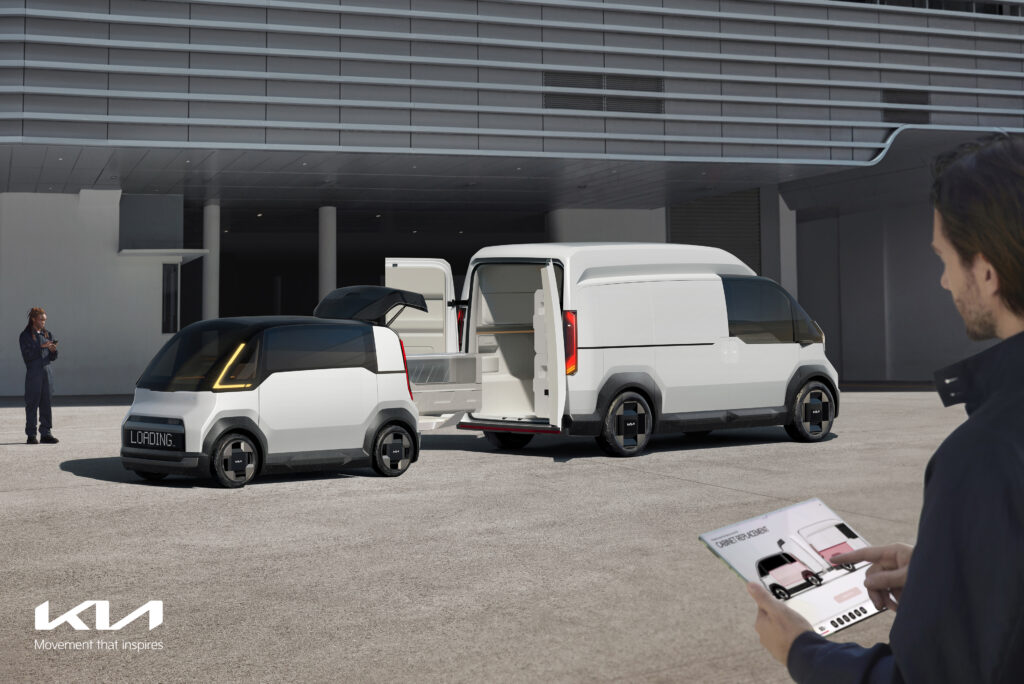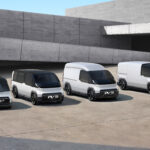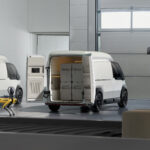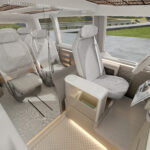Kia Announces Platform Beyond Vehicle Business

Kia PBV Concept Lineup

Kia has revealed its Platform Beyond Vehicle (PBV) future strategy at the 2024 Consumer Electronics Show (CES) in Las Vegas. Kia’s PBV business will initially be based around the introduction of an all-new, modular vehicle, previewed by the Kia Concept PV5.
This future vision was presented alongside a multi-phase plan with the goal of PBVs revolutionizing the mobility industry while helping to advance Hyundai Motor Group’s ambitions in robotics, Advanced Air Mobility (AAM), and autonomous driving.
Kia PBVs are intended to be a total mobility solution that combines fit-for-purpose EVs with advanced software solutions based on the Hyundai Motor Group’s software-to-everything, or SDx, strategy. As a Platform Beyond Vehicle, Kia PBVs are designed to open the door to new businesses and lifestyles by redefining the concept of space thanks to advanced, tailored interiors that provide freedom and flexibility.
“Kia’s PBV business represents our vision of going beyond the traditional concept of automobiles by fulfilling the unmet needs of diverse customers and communities through optimized vehicles and services catering to specific market and business circumstances,” said Ho Sung Song, Kia Corporation President and CEO.

A vision for future mobility
The launch of Kia’s PBV business will see the brand commit to providing a varied range of customized vehicle types to meet customers’ individual requirements. Determined to overcome existing restrictive and one-dimensional industry product line-up offerings, Kia believes its new approach to PBVs can help solve various mobility challenges encountered by individuals and organizations with limited transportation options.
Kia’s PBV offering will be built around a dedicated business system, integrating vehicles, software, and future technologies to deliver added value.
The brand’s PBV roadmap, divided into three distinct phases, illustrates how Kia PBVs will be pivotal in realizing the Group’s SDx vision as devices that offer tailored solutions according to customer usage patterns.
In phase one, Kia plans to introduce the Kia PV5, a versatile EV optimized for major domains such as hailing, delivery and utilities that features conversion capability for diverse customer needs. Enhanced data connectivity between vehicles and external data such as route or delivery information is intended to enable convenient operation of multiple vehicles as a software-defined fleet.
The plan for phase two is to see the completion of the dedicated PBV model line-up, with PBVs evolving into AI-based mobility platforms that use data to interact with users and help keep vehicles updated. An integrated PBV solution can help provide a customized, seamless experience across devices and software.
In phase three, Kia PBVs are expected to evolve into highly customizable, bespoke mobility solutions by integrating with the future mobility ecosystem.

Designed to make users’ lives easier
Utilizing technology to flexibly address the diverse demands of customers, the design strategy is to enable a single vehicle chassis to be used to fulfill multiple mobility needs. Behind a fixed cab, or ‘driver zone’, a variety of interchangeable upper bodies, or ‘life modules’, can be connected to the base vehicle via a hybrid electromagnetic and mechanical coupling technology, turning the PBV into a taxi during the day, to a delivery van at night, and a personal recreational vehicle on weekends.
The weldless body structure assembly is designed to enable the length of moveable members to be flexibly adjusted according to vehicle use purpose. Shipped in standardized, convenient kit form, Dynamic Hybrid technology is intended to allow for the quick and simple in-field transformation of a Kia PV5.
The design of Kia’s PBVs is inspired by robust, simple and clever tools and goes beyond mere aesthetics. Kia’s mission is to design PBVs that are simple and intuitive to operate and engage with, regardless of where, when or how they are used.
Whether the purpose of the vehicle is to transport people, move goods, or meet logistics or personal mobility needs, Kia’s goal is to ensure each PBV shares a consistent quality of design that reflects its solid, robust nature and projects a dependable and highly capable attitude.
A combination of a simple yet robust surface language combined with expressive graphics seamlessly unifies the four Concept PV5 models, despite their diverse natures. On each vehicle, large doors open out to reveal an exceptionally accommodating pillarless opening that provides easy ingress and egress. Inside, the extended wheelbase and electric platform ensure wide, flat open spaces to offer stowage and usage possibilities.

Inspiration becomes reality
Kia plans to create an ecosystem that fosters interaction between PBVs. With extensive modularity — including the ability to share features across all vehicles — Kia hopes its PBVs will enhance versatility, opening up possibilities to cater to the needs of both businesses and individuals.
In line with phase one, Kia plans to make various versions of the PV5 available in the future, including Basic, Van, High Roof, and Chassis Cab. In the future, Kia also plans to introduce a Robotaxi model developed with Motional (a joint venture between HMG and Aptiv), which aims to provide a revolutionary autonomous hailing experience for passengers.
During phase two, symbiosis of the PBV ecosystem will be complimented by two further models, the ‘PV7’ and ‘PV1’, utilizing cabinet and frame systems to enhance interaction and connectivity among vehicles based on the modular concept.
- PV7 — The largest product in the PBV line-up, designed with more interior space, impressive driving range, and enhanced functionalities.
- PV1 — The smallest product in the line-up, PV1 is designed for agile and short-distance logistics transportation, using driving modules to minimize turning radius even in narrow spaces.
- PBV modularity — An integrated rail system on the vehicle’s ceiling, floor, and side panels, as well as on the exterior, enables customization of the vehicle to meet individual customer needs. This system is designed to enable the seamless transfer of goods and items between vehicles, using cabinets and frames. The ‘rails’ within this ecosystem simplify the movement of items between vehicles, while the modular design of the ‘tiles’ and functional accessories, such as speakers and shelves, offer limitless flexibility for a wide range of scenarios.
“Kia PBVs will initiate a new era of seamless everyday business and lifestyle solutions. We hope to make our customers’ lives easier and better, whether they’re stationary or on the move, offering exceptional flexibility and customization through radical modularization,” said Karim Habib, Executive Vice President and Head of Kia Global Design.
To take full advantage of the opportunities enabled by PBVs, Kia plans to launch a dedicated business system, encapsulating various aspect of the process, from the product line-up to integration of software solutions, and global partnerships.
The product line-up outlined above will be augmented by the introduction of a customer participation-based development process, utilizing customer input and feedback to create more tailored, mission-specific solutions.
Kia is taking significant steps to meet the diverse demands of customers by constructing a PBV-dedicated EVO plant in Autoland Hwaseong, Korea. This factory will implement a hybrid production approach, combining conveyor and cell-based methods. Through collaboration with global conversion partners, Kia will be able to offer conversion models for various PBV line-ups, catering to different customer preferences. The factory is scheduled to become operational in 2025 and is expected to have an annual capacity of 150,000 units.
The brand’s solutions for In-Vehicle Infotainment (IVI), Fleet Management Systems (FMS), and charging aims to leverage vehicle software-based data and AI technologies to further enable customer-centric solutions, predictive maintenance suggestions to reduce downtime, and charging programs tailored to the customer’s business operating environment.
Kia’s PBV IVI solution aims to enhance daily life by recognizing user preferences in real-time and providing relevant contextual data. It is expected to offer access to the Kia PBV App Market and third-party apps, allowing customers have information and entertainment content on the go. By connecting with business-specific apps previously limited to mobile devices, it seeks to improve service convenience and information reliability, providing a holistic user experience across different hardware form factors.
The fleet management solution for Kia PBVs will be designed to allow customers to efficiently oversee multiple vehicles, providing insights on sales, inventory, and deliveries, benefiting mobility and logistics businesses. Features may include inventory monitoring, temperature control, and intelligent route planning for efficiency. The solution is intended to streamline fleet management with real-time data and AI integration for predictive maintenance and optimal operational efficiency.
Kia’s EV charging solution will be designed to optimize charging schedules by considering battery charge levels, routes, schedules, and breaks. Additionally, Kia aims to provide a total energy solution by utilizing advanced charging infrastructure, allowing high-density energy batteries to power mobile devices and emergency equipment. This can eventually be made possible through innovations like Vehicle-to-Everything (V2X) technology.
This integration of IVI, FMS, and charging systems is expected to be delivered via unified software, enabling packaged solutions adaptable to various business environments. Kia has established partnerships with companies like Uber, Coupang, CJ Logistics, Kakao Mobility, and Dubai Taxi Corporation to further enhance its PBV-dedicated business system.
“The Kia PBV business is the pinnacle of our customer-centric business approach. With the aim of developing PBVs and solutions tailored to their business environments, we are confident that these strong partnerships will be a driving force on the road to becoming a sustainable mobility solutions provider,” said Pierre-Martin Bos, Vice President and Director of PBV.
Future business and affiliate partnerships may help strengthen the integration of robotics, AAM, and autonomous driving to support a PBV mobility solution within smart city environments.
- Robotics — Kia is leveraging robotics, including Boston Dynamics’ Stretch and Spot robots, to enhance logistics automation and round-the-clock quality control at their smart factories. These efforts aim to uncover new business opportunities through collaborations and drive innovation.
- AAM — Kia is collaborating with Hyundai Motor Group affiliate Supernal, to expedite the development of smart cities by introducing multi-modal services and mobility hub businesses based on advanced air mobility.
- Autonomous driving — together with Motional, Hyundai Motor Group plans to expand beyond personal autonomous driving technology into the business phase. This is underway with plans for the development of a software based PV5 Robotaxi. This collaboration aims to combine Kia’s competitive strengths with Motional’s advanced Level 4 autonomous driving technology to expand global business opportunities.
As such, Hyundai Motor Group’s software capabilities transcend beyond vehicles and extend to various areas of mobility, such as robotics, aircraft, and autonomous driving, aiming to enable operation, control, and management, fostering an era of hyper-connectedness between people and things.

Going ‘beyond mobility’
Kia’s PBV models can redefine how customers live their lives. Boundary-pushing design can lead to creating new vehicle interiors and can eventually expand to both mobile and stationary spaces, enhancing daily life, work, and leisure.
Since the brand’s relaunch in 2021, Kia has embarked on a journey to adapt effectively to the rapidly changing market through its Plan S strategy. With award-winning models including the EV6 and EV9 having helped to successfully establish the company as a leader in the design and manufacture of EVs, Kia aims to solidify its position as a top-tier sustainable mobility solutions provider through the launch of subsequent vehicles, such as the EV3, and EV4. In pursuit of achieving its vision and meeting diverse customer needs, Kia’s brand relaunch has led additionally to a transition towards a sustainable customer-centric management system.
Leading the way
Kia’s presence at CES 2024 marks a return to the industry-leading Consumer Electronics Show after a five-year absence.
The brand will be presenting two exhibitions at the event. Located in the LVCC West Hall, Kia’s PBV exhibition is based on the theme ‘Place of Inspiration’. The exhibition showcases the diverse ways in which PBVs can inspire and shape individuals’ lives through a range of lifestyle and experience displays and features five PBV concept vehicles.
The four display areas take the form of visual representations of a park, city, home and factory bathed in four visually distinctive colors. Together, the displays highlight the multiple applications and benefits of Kia’s PBV technology in addition to showcasing Kia’s brand values and ‘Opposites United’ design philosophy.
Kia’s second exhibition is located in the CES Central Plaza, under the theme of ‘EV Life for Everyone.’ Featuring a futuristic Kia Connected Home™, the display showcases the Kia Concept EV3, Concept EV4 and the EV6 and EV9 production models, in addition to an exciting EV9 driving technology simulation, a 10 innovative items exhibition, and Vehicle-to-Home (V2H) power supply (coming in the future) and Vehicle-to-Load (V2L) camping demonstrations.





















